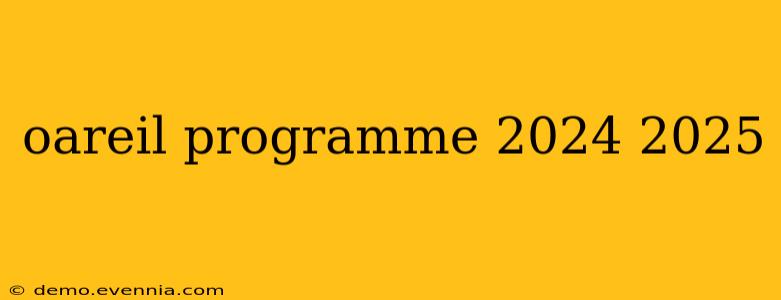Assuming "OAREL" is a typo and you intended "OAREIL," I'll provide a comprehensive guide to creating a hypothetical OAREIL program for 2024-2025. Since there's no publicly available information on a program with this name, this response will focus on creating a framework for such a program, which can be adapted to any specific context or initiative. Remember to replace the placeholder information with your actual details.
Defining the OAREIL Programme: Goals and Objectives
Before detailing the program's structure, it's crucial to define its core purpose. What specific problem does the OAREIL programme aim to solve? What are its overarching goals and measurable objectives? For example:
- Goal: To improve [Specific area, e.g., digital literacy, environmental sustainability, economic development] within [Target community/region].
- Objectives:
- Increase [Metric, e.g., participation rates] by [Percentage] by [Date].
- Reduce [Metric, e.g., carbon emissions, unemployment rates] by [Percentage] by [Date].
- Improve [Metric, e.g., community engagement, knowledge retention] as measured by [Assessment method].
Programme Structure and Activities (2024-2025)
The OAREIL programme should have a clearly defined structure encompassing various activities across the two-year period. This could include:
Phase 1: Foundation (2024)
- Q1 2024: Needs assessment, stakeholder engagement, resource allocation, development of training materials and program curriculum. This phase involves thorough research to understand the target audience's needs and tailor the program accordingly.
- Q2 2024: Recruitment of participants, initial training sessions, and the launch of pilot programs. This is a crucial phase for establishing a solid foundation.
- Q3 2024: Monitoring and evaluation of pilot programs, gathering feedback from participants, and making necessary adjustments to the program design. Feedback is vital for iterative improvement.
- Q4 2024: Program expansion, outreach activities, and securing additional funding (if applicable). This phase focuses on scaling the successful elements of the pilot program.
Phase 2: Implementation and Scaling (2025)
- Q1 2025: Full-scale implementation of the OAREIL programme, focusing on wider outreach and engagement. This involves putting all the previous work into action on a larger scale.
- Q2 2025: Ongoing training and support for participants, monitoring program progress, and addressing any challenges that may arise. Continuous support is key to long-term success.
- Q3 2025: Mid-year review and evaluation, assessing progress towards objectives and making adjustments as needed. This provides an opportunity for course correction.
- Q4 2025: Final evaluation, reporting on program outcomes, dissemination of findings, and planning for future iterations of the OAREIL programme. Documenting success and failures is vital for future improvements.
Key Performance Indicators (KPIs)
Regularly track KPIs to measure the success of the OAREIL programme. Examples include:
- Participant satisfaction: Measured through surveys and feedback sessions.
- Program completion rates: Tracking the percentage of participants who successfully complete the program.
- Achievement of objectives: Monitoring progress towards the pre-defined objectives.
- Impact on the target community: Assessing the overall impact of the program on the community.
Conclusion
The OAREIL programme, as outlined above, provides a flexible framework that can be adapted to fit various contexts. By clearly defining goals, structuring activities logically, and regularly monitoring KPIs, you can increase the likelihood of a successful and impactful program. Remember to replace the placeholder information with specifics relevant to your initiative. Detailed budgeting, timelines, and risk mitigation strategies should also be incorporated into a comprehensive program plan.

